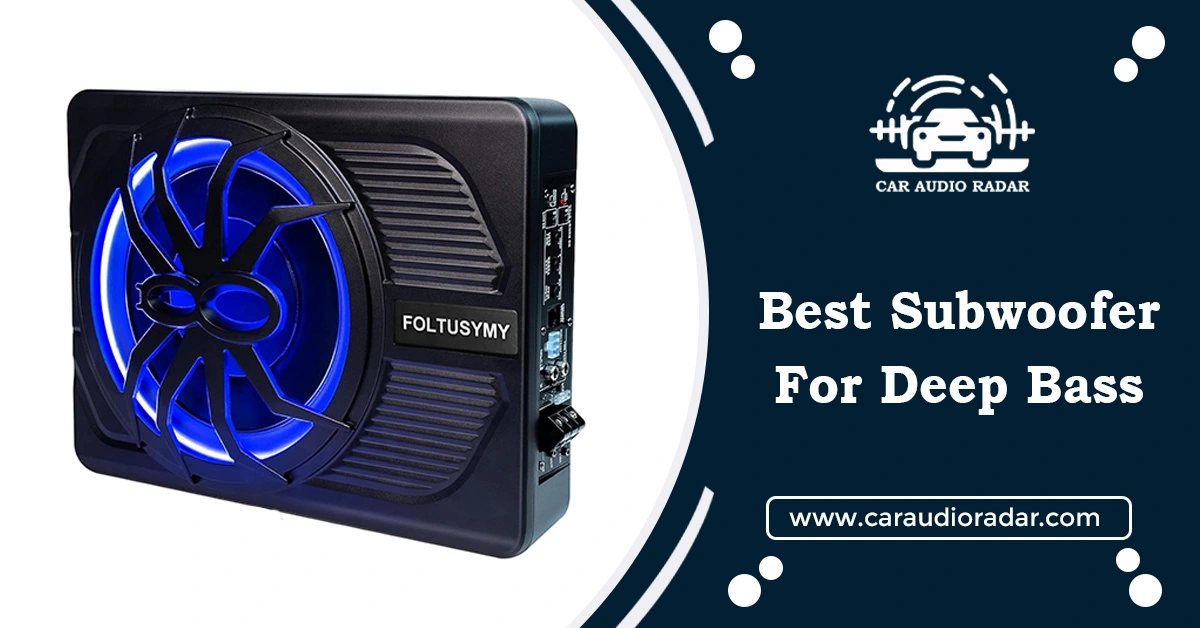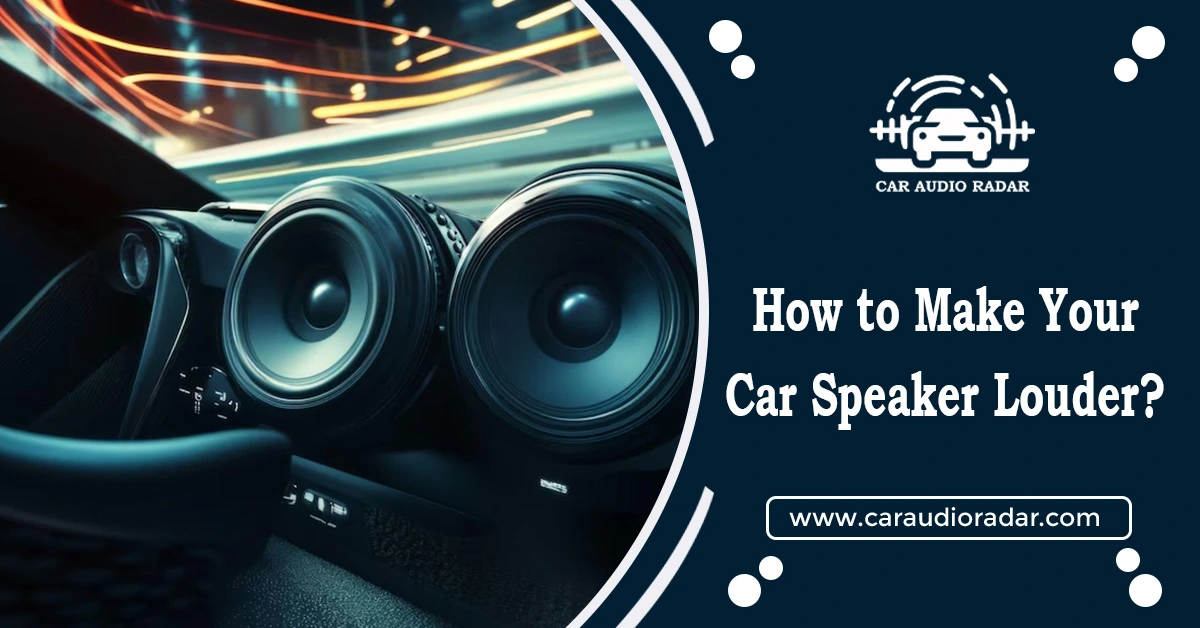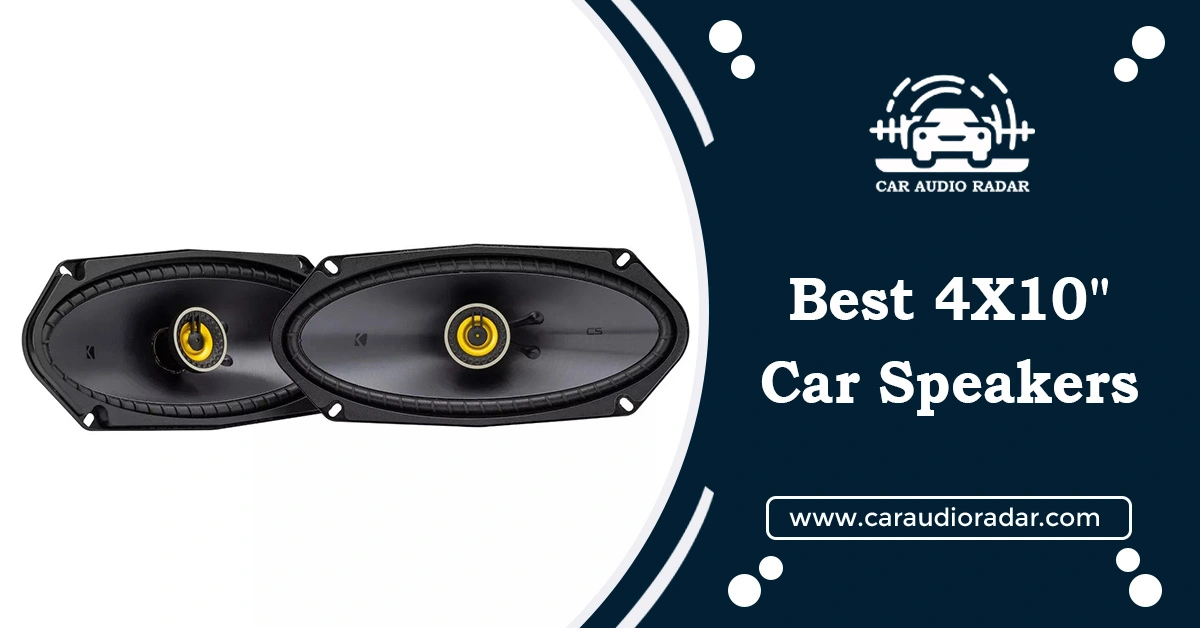
Jump to
How To Measure What Size Speakers Are In My Car?

What Speaker Size Fits My Car? How do I measure the speaker’s size? What happens if I use speakers that are the wrong size? How can I purchase speakers that are the right size?
To upgrade your car’s sound system, the first thing to consider is finding speakers that fit, should you desire to do so. If you use car speakers that are the wrong size, it can mess up the sound and harm your car’s audio system.
With many options available, it might be confusing. In this article, we’ll break down the types of speakers and help you choose the right ones for your car.
Types of Car Speakers
Two types of car speakers are available in the market:
- Component Car Speakers
- Coaxial Car Speakers
Component Car Speakers
Each standard component car speaker set contains a pair of woofers, tweeters, and a crossover. Woofers deal with low frequencies, and tweeters deal with high frequencies. Crossover is a filter that ensures the low frequencies go towards the woofers and the high-frequency sounds go to the tweeters.
Coaxial Car Speakers
Standard coaxial speakers usually have a woofer, midrange speaker, and tweeter all put together in one unit. These speakers are called ‘coaxial’ because all three (or sometimes just two) speakers share the same line or axis.
What Speaker Size Fits My Car: How To Measure
Here are some methods described. With their help, you can easily measure car speakers’.
Method 1: The Usual Method: Check the Manual
This is a simple method for checking which speakers fit in your car best. Mostly, every vehicle has its own manual. If you don’t find a manual, search for it online as a free PDF or find it on the manufacturer’s website.
Method 2: The Simple Way: Measure Things
Grab these simple tools for measuring car speaker size:
- Measuring Tape or ruler
- Flashlight (if you want)
Here’s an easy way to figure out your speaker size:
Measure the Speaker Diameter
- Use a Measuring Tape or ruler.
- Measure across the speaker from one outer edge to the opposite outer edge.
- This measurement gives you the speaker’s diameter.
Measure the Speaker Basket Depth
- Measure the distance from the back of the speaker frame to the front of the speaker cone.
- Use a Measuring Tape or ruler.
- Note down these measurements on paper and compare them with standard car speaker sizes.
Remember: It’s crucial to be accurate when measuring. If the measurement is not accurate, when you buy speakers, they will fit your car’s audio system.
Method 3: Another Way: Measure Brackets
- Checking your speaker size can be super easy by measuring brackets.
- Sometimes, you can find the measurements on the mounting bracket if you take out a speaker. This is more accurate than a tape measure and gives you the exact dimensions to replace it.
Remember: Not all cars have this option, so you might not be able to measure car speaker size with this method.
Method 4: Use Online Tools
Many online tools can instantly tell you if a speaker will fit in your car’s audio system brackets. However, this method works best if you have the original brackets. You might need more info or try a different approach if you have aftermarket ones.
For an easy time, you can use tools like Online Car Stereo or the Car Toys Fit Guide. If you’re buying from Amazon, you’re in luck. Amazon lets you create a ‘virtual garage’ to quickly see which speakers will fit your car.
It’s a reliable method for most people, but it works best if everything in your car is still in stock. It means everything is original, and no one has replaced or modified anything.
Method 5: The Try-and-See Method
Another method to find the right size for your car speakers is by trying different sizes until you find the one that fits best. It might take some time and effort, but if you’re eager to learn more about car speaker sizes, this is a method to consider.
Understanding Speaker Size: Common Car Speaker
Car speakers come in different sizes. Here are some common ones are described:
- 3-4 inches are known as Smaller speakers.
- 5-6.5 inches are known as Mid-size speakers.
- 6.75- above are known as Larger speakers.
3.5 Inches
3.5-inch speakers can fit in cars depending on your car’s make and model, the music you enjoy, and your personal preferences.
These small 3.5″ subwoofers are commonly found in basic or original car audio systems. They work well for low to mid-range frequencies and offer decent audio quality. These are suitable for high and mid-range audio but not great for bass.
4.0 Inches
To resolve equalizer issues, reset it to its default setting. This simple modification should eliminate any popping sounds produced by the system. If the driver causes the issue, check the DPC latency. This can be determined using a “DPC latency check” or updating the driver.
4x6 Inches
4×6 speakers are a common size for car audio, especially in older cars made to fit this speaker size. People usually consider them medium-sized and they can provide a nice balance of power and clear sound.
In a car, 4×6 speakers work well for mid-range and higher frequencies like vocals and instruments. When used with a good sound system, they can produce great sound and volume as front or rear subwoofers.
When placed correctly and compatible with your car’s audio system, 4×6 speakers won’t harm your car. Upgrading to better speakers can make your music sound better, and you’ll enjoy it more. Just make sure the new speakers are installed in the right place to avoid damaging your car or music equipment.
5.25 Inches
These speakers offer a good balance between cost and quality for car stereos. Car manufacturers usually install them in the front and back doors, as well as the rear side panels or back deck.
They have a better midbass response than smaller speakers, which can enhance your audio system. Speakers of 5.25-inch size are available in various forms such as coaxial, midrange, midbass-only, and component combinations. Coaxial speakers are favored as they merge a woofer and a tweeter. Conversely, component sets divide the woofer and tweeter for a more distinct sound.
These speakers usually handle power in the range of 25W to 55W, which is often enough for many car sound systems. A speaker converter can be used to fit 5.25-inch speakers into a car that originally had larger speakers. If you already have speakers you want to use, this can save you money.
5.7 Inches
5.7-inch speakers, also known as 5×7 or 6×8 speakers, are another common size for car speaker systems.
They’re bigger and can give a fuller and stronger sound with better midrange response. 6-inch speakers come in different types like coaxial, component, or just midrange/midbass, like other speaker sizes.
These can function as either front or back speakers and are frequently found in vehicles with larger speaker slots in the doors or deck. 5.7-inch speakers can handle 50W–100W RMS power. With a matching amplifier or head unit, they can provide more volume and a wider dynamic range.
6.0 Inches
If you’re looking for good bass quality without spending too much, 6-inch car audio speakers are a great choice.
They’re bigger and can give a fuller and stronger sound with better midrange response. Speakers of 6-inch size are available in varieties such as coaxial, component, or solely midrange/midbass, similar to other speaker dimensions.
These speakers can be used in the front or back of a vehicle. They are typically installed in cars that have larger speaker slots in the doors or rear area. Six-inch speakers can handle 50W to 100W RMS with an amp or head unit. This means more volume and a wider dynamic range.
6.5 Inches
These speakers give you a good mix of audio quality and easy installation. They possess a superior low-frequency rating compared to 6-inch speakers and are slightly bigger.
6.5-inch speakers come in types like coaxial, component, or midrange/midbass-only, just like other speaker sizes. You can use them as speakers in the front or back of a car. Cars with larger speaker openings in the doors or rear deck often show this.
With power usually ranging from 50W to 120W RMS, 6.5-inch speakers can handle more power than smaller speakers. With a matching amplifier or head unit, they can increase the volume and dynamic range. These speakers are easy to find and aren’t expensive, so they fit into various budgets. They offer a versatile sound for different music styles, making them a great choice for car audio enthusiasts.
6.75 Inches
Speakers of 6.75 inches are another common choice for car sound systems. Frequent selection occurs for enhanced car audio performance and increased bass.
They’re a bit larger than 6.5-inch speakers and have a better low-frequency rate. 6.75-inch speakers come in types like coaxial, component, and midrange/midbass-only, similar to the previous sizes.
You can use them as back or front speakers. They are often already in cars with larger speaker openings in the doors or car shelf. Speakers of 6.75 inches can manage 60W to 120W RMS, giving them an edge over their smaller counterparts. This feature helps them produce a stronger and complete sound, especially when used with a matching amplifier or head unit.
These speakers offer a more profound and potent bass response compared to smaller ones. They produce a better sound because they have bigger cones and can move more air. However, remember that you may need extra parts, like a speaker or amplifier, to enjoy their advantages fully.
6.8 Inches
It’s not easy to find car audio systems with 6.8-inch speakers because they’re not very common among manufacturers. Some companies make 6.8-inch speakers specifically for certain cars or for aftermarket installations. 6.8-inch speakers perform similarly to 6.5-inch and 6.75-inch speakers in terms of midrange, high-frequency, and bass.
They are capable of managing moderate power levels, typically ranging from 50W to 100W RMS. This characteristic makes them an excellent option for individuals seeking improved bass quality without the necessity for extra amplification. These speakers can serve as replacements for original speakers in vehicles that have larger speaker openings. This can enhance bass quality and improve the overall listening experience.
6.9 Inches
6.9-inch speakers are not a common size for car audio systems, and they are not easily found in the market. So, it might be challenging to find a variety of 6.9-inch speakers from different manufacturers.
If you’re thinking about getting 6.9-inch car speakers, make sure they work well with your sound system and are easy to install.
Things to Consider Before Buying Car Speakers
- Woofer Quality: Check the woofer quality before looking at other features. A good woofer has sturdy and lightweight materials for better bass. Manufacturers often use materials like polypropylene to create a more accurate bass response.
- Sensitivity: Sensitivity measures how much sound a speaker can produce. If your car’s stereo has low power (around 15W RMS per channel or less), go for a speaker with high sensitivity (over 90dB). For high-power stereos, choose a speaker with low sensitivity.
- Power-Handling: The RMS rating shows the power-handling of a speaker, indicating the continuous power it can handle. You don’t need a speaker with a high RMS rating for a low-powered system. For a high-powered system, the RMS rating should match the power source output for the best experience. We recommend getting speakers with an RMS rating that matches the power source output.
- Impedance: Speaker Impedance is like the electrical resistance of a speaker. Many car speakers have 4 ohms, but some can be 2 or 8 ohms. It’s crucial to pick speakers with the right impedance for your car stereo, as using the wrong impedance can harm the speakers and amplifiers.
Conclusion
Which Speaker Size Fits My Car? What size speaker should I get for my car? It may seem challenging to choose the best speakers for your vehicle. However, if you take into account the points we mentioned earlier, you will be able to make a wise decision.
Remember to think about the size of your current car speakers, how much power your stereo can handle, and things like how sensitive the speakers are and their impedance. With some research, you’ll find just the right speakers to improve your car’s sound system, so you can enjoy your music even more.
Frequently asked Questions (FAQs)
To find fitting speakers, know your car’s bass system’s speaker sizes. Check the owner’s manual or quickly search online with your car’s make and model.
No, car speakers aren’t universal. They come in different sizes and shapes to fit various car makes and models. The width of a car speaker’s woofer, ranging from 3.5 inches to 10 inches or more, indicates its size.
The cone material in your car’s speaker, related to its size, impacts sound quality. Among materials like aluminum, paper, or cloth, aluminum is often the best for longer lifespan and better sound quality.
The number of speakers varies by car type. Some have as few as two (usually on the front doors), while others may have up to nine. For a good car audio system, five speakers are usually enough: one on each door and perhaps a 12-inch subwoofer in the trunk for bass and overall sound quality.
Cooper Katzeel
Car Enthusiast
Cooper Katzel, a dedicated car enthusiast, delves into the world of automobiles and audio systems. With a deep interest in cars and a focus on superior sound, Cooper’s expertise traverses the spectrum. His journey is a delightful exploration of automotive wonders and the world of car speakers. Cooper’s passion and technical know-how make him a trusted advisor for car enthusiasts.
Follow On Instagram
Recent Posts
- All Post
- Blog
- Car Speaker
- Car Subwoofer
- Pro Tips & Guides
- Back
- Speaker Wire



Dream Life in Paris
Questions explained agreeable preferred strangers too him her son. Set put shyness offices his females him distant.


